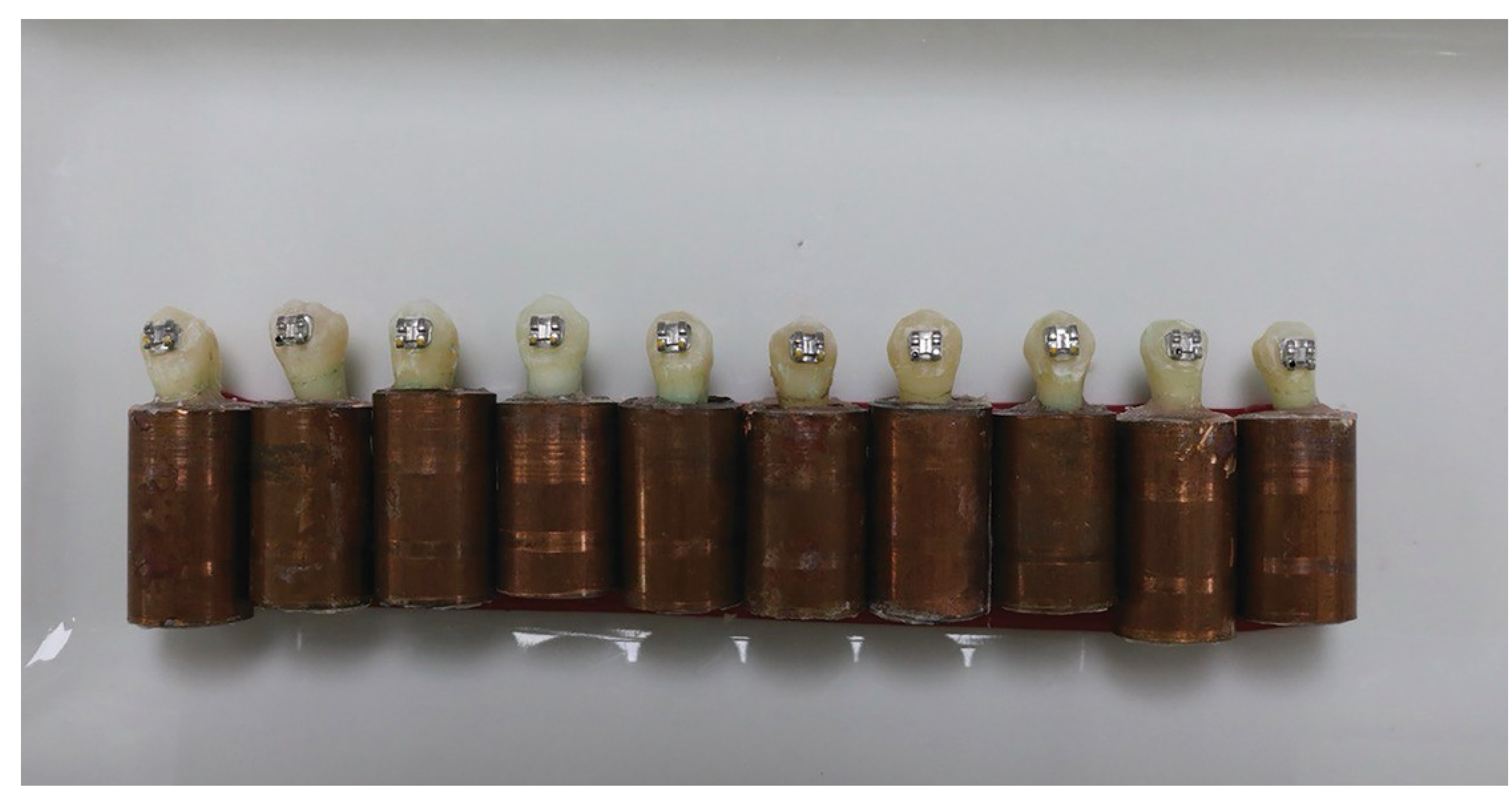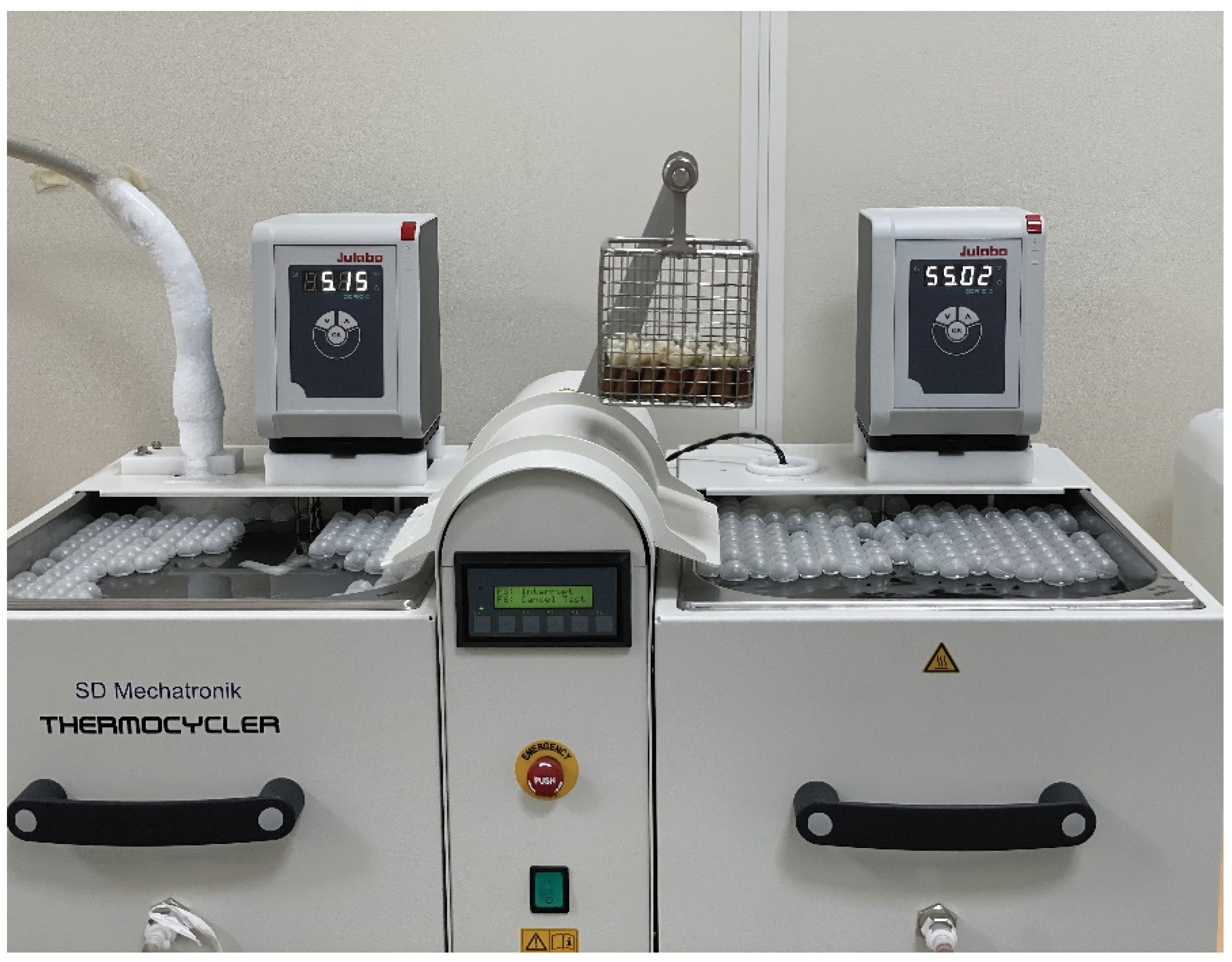Effects of Different Adhesive Systems and Orthodontic Bracket Material on Enamel Surface Discoloration: An In Vitro Study
Abstract
1. Introduction
2. Materials and Methods
2.1. Baseline Tooth Color Assessment
2.2. Grouping
2.3. Bonding of the Brackets
2.4. Storage and Thermocycling
2.5. Debonding of the Brackets
2.6. Post-Debonding Tooth Color Assessment
2.7. Statistical Analysis
3. Results
4. Discussion
Author Contributions
Funding
Institutional Review Board Statement
Informed Consent Statement
Data Availability Statement
Acknowledgments
Conflicts of Interest
References
- Sandison, R.M. Tooth surface appearance after debonding. Br. J. Orthod. 1981, 8, 199–201. [Google Scholar] [CrossRef] [PubMed]
- Ogaard, B. Prevalence of white spot lesions in 19-year-olds: A study on untreated and orthodontically treated persons 5 years after treatment. Am. J. Orthod. Dentofac. Orthop. 1989, 96, 423–427. [Google Scholar] [CrossRef] [PubMed]
- Zaher, A.R.; Abdalla, E.M.; Abdel Motie, M.A.; Rehman, N.A.; Kassem, H.; Athanasiou, A.E. Enamel colour changes after debonding using various bonding systems. J. Orthod. 2012, 39, 82–88. [Google Scholar] [CrossRef] [PubMed]
- Joo, H.J.; Lee, Y.K.; Lee, D.Y.; Kim, Y.J.; Lim, Y.K. Influence of orthodontic adhesives and clean-up procedures on the stain susceptibility of enamel after debonding. Angle Orthod. 2011, 81, 334–340. [Google Scholar] [CrossRef] [PubMed]
- Wu, H.M.; Ye, C.; Chen, D. Comparative study of enamel discoloration related to bonding with different orthodontic adhesives and cleaning-up with different procedures. Shanghai Kou Qiang Yi Xue 2018, 27, 257–260. [Google Scholar]
- Almosa, N.A.; Sibai, B.S.; Rejjal, O.A.; Alqahtani, N. Enamel demineralization around metal and ceramic brackets: An in vitro study. Clin. Cosmet. Investig. Dent. 2019, 11, 37–43. [Google Scholar] [CrossRef]
- Brusca, M.I.; Chara, O.; Sterin-Borda, L.; Rosa, A.C. Influence of different orthodontic brackets on adherence of microorganisms in vitro. Angle Orthod. 2007, 77, 331–336. [Google Scholar] [CrossRef]
- Knoernschild, K.L.; Rogers, H.M.; Lefebvre, C.A.; Fortson, W.M.; Schuster, G.S. Endotoxin affinity for orthodontic brackets. Am. J. Orthod. Dentofac. Orthop. 1999, 115, 634–639. [Google Scholar] [CrossRef]
- Janiszewska-Olszowska, J.; Szatkiewicz, T.; Tomkowski, R.; Tandecka, K.; Grocholewicz, K. Effect of orthodontic debonding and adhesive removal on the enamel-current knowledge and future perspectives—A systematic review. Med. Sci. Monit. 2014, 20, 1991–2001. [Google Scholar]
- Pandian, A.; Ranganathan, S.; Padmanabhan, S. Enamel color changes following orthodontic treatment. Indian J. Dent. Res. 2017, 28, 330–336. [Google Scholar] [CrossRef]
- Korkmaz, Y.N.; Bulut, M. Effect of mouthwashes on the discoloration of bracket-bonded tooth surfaces: An in vitro study. Clin. Oral Investig. 2020, 24, 3855–3861. [Google Scholar] [CrossRef]
- de Melo Oliveira, I.; Santana, T.R.; Correia, A.C.C.; Fontes, L.S.; Griza, S.; Faria, E.S.A.L. Color heterogeneity and individual color changes in dentin and enamel bleached in the presence of a metallic orthodontic bracket. J. Esthet. Restor. Dent. 2021, 33, 262–268. [Google Scholar] [CrossRef]
- George, J.; Mathews, T.A. Spectrophotometric Analysis of Tooth Discoloration after Bracket Debonding Induced by Coffee and Tea Grown in South India: An In vitro Study. J. Interdiscip. Dent. 2018, 8, 1. [Google Scholar] [CrossRef]
- Babikir, M.O.; Gilada, M.W.; Fahmy, F.; Ismail, I.A.; Alhajj, M.N.; Fadul, A.A.; Elasyouti, A. Effect of Commonly Consumed Beverages on Color Stability of Polymethyl Methacrylate Denture Base Material. Compend. Contin. Educ. Dent. 2019, 40, e1–e8. [Google Scholar]
- Ghavami-Lahiji, M.; Firouzmanesh, M.; Bagheri, H.; Jafarzadeh Kashi, T.S.; Razazpour, F.; Behroozibakhsh, M. The effect of thermocycling on the degree of conversion and mechanical properties of a microhybrid dental resin composite. Restor. Dent. Endod. 2018, 43, e26. [Google Scholar] [CrossRef]
- Valizadeh, S.; Hashemi, S.F.; Hashemikamangar, S.S.; Kharazifard, M.J. Microleakage of a Self-adhesive Composite of Class V Cavities: Effect of Surface Treatment and Thermocycling. J. Contemp. Dent. Pract. 2020, 21, 781–786. [Google Scholar]
- Fusco, A.; Ahmed, S.; Link, J.; Al-Talib, T.; Abubakr, N.H. Performance of Different Orthodontic Brackets after Exposure to Dietary Components: An in Vitro Pilot Study. Open J. Stomatol. 2021, 11, 341–348. [Google Scholar] [CrossRef]
- Gursoy, S.; Acar, A.G.; Sesen, C. Comparison of metal release from new and recycled bracket-archwire combinations. Angle Orthod. 2005, 75, 92–94. [Google Scholar]
- Novianti, S.; Siregar, E.; Anggani, H.S. Corrosion Resistance of Stainless Steel Brackets After Thermal Recycling by Direct Flaming. Pesqui. Bras. Em Odontopediatria E Clínica Integr. 2019, 19. [Google Scholar] [CrossRef]
- Eliades, T.; Athanasiou, A.E. In Vivo aging of orthodontic alloys: Implications for corrosion potential, nickel release, and biocompatibility. Angle Orthod. 2002, 72, 222–237. [Google Scholar]
- Hodges, S.J.; Spencer, R.J.; Watkins, S.J. Unusual indelible enamel staining following fixed appliance treatment. J. Orthod. 2000, 27, 303–306. [Google Scholar] [CrossRef]
- Haghighi, A.H.S.; Emami, M.; Fakhri, E.; Rezaei, Y. Effects of Orthodontic Adhesives on Dental Enamel Color Alteration Using Chemically Cured and Light-Cured Composites. Front. Dent. 2020, 17, 1. [Google Scholar]
- Boncuk, Y.; Cehreli, Z.C.; Polat-Ozsoy, O. Effects of different orthodontic adhesives and resin removal techniques on enamel color alteration. Angle Orthod. 2014, 84, 634–641. [Google Scholar] [CrossRef]
- Cal-Neto, J.P.; Miguel, J.A. Scanning electron microscopy evaluation of the bonding mechanism of a self-etching primer on enamel. Angle Orthod. 2006, 76, 132–136. [Google Scholar]
- Horiuch, S.; Kaneko, K.; Mori, H.; Kawakami, E.; Tsukahara, T.; Yamamoto, K.; Hamada, K.; Asaoka, K.; Tanaka, E. Enamel bonding of self-etching and phosphoric acid-etching orthodontic adhesives in simulated clinical conditions: Debonding force and enamel surface. Dent. Mater. J. 2009, 28, 419–425. [Google Scholar] [CrossRef]
- Al Maaitah, E.F.; Abu Omar, A.A.; Al-Khateeb, S.N. Effect of fixed orthodontic appliances bonded with different etching techniques on tooth color: A prospective clinical study. Am. J. Orthod. Dentofac. Orthop. 2013, 144, 43–49. [Google Scholar] [CrossRef]
- Al Shamsi, A.H.; Cunningham, J.L.; Lamey, P.J.; Lynch, E. Three-dimensional measurement of residual adhesive and enamel loss on teeth after debonding of orthodontic brackets: An in-vitro study. Am. J. Orthod. Dentofac. Orthop. 2007, 131, 301.e9–301.e15. [Google Scholar] [CrossRef]
- Corekci, B.; Irgin, C.; Malkoc, S.; Ozturk, B. Effects of staining solutions on the discoloration of orthodontic adhesives: An in-vitro study. Am. J. Orthod. Dentofac. Orthop. 2010, 138, 741–746. [Google Scholar] [CrossRef]
- Zhao, X.; Ren, Y.F. Surface Properties and Color Stability of Resin-Infiltrated Enamel Lesions. Oper. Dent. 2016, 41, 617–626. [Google Scholar] [CrossRef]
- Vieira-Junior, W.-F.; Vieira, I.; Ambrosano, G.-M.-B.; Aguiar, F.-H.-B.; Lima, D.-A.-N. Correlation between alteration of enamel roughness and tooth color. J. Clin. Exp. Dent. 2018, 10, e815–e820. [Google Scholar] [CrossRef]


| Material | Brand Name | Composition | Manufacturer |
|---|---|---|---|
| Ceramic brackets | Clarity™ Advanced ceramic brackets | Polycrystalline alumina | 3M Unitek, Monorovia, CA, USA |
| Metal brackets | Victory Series™ Low Profile | Stainless Steel | 3M Unitek, Monorovia, CA, USA |
| Acid etching gel | Acido Gel 37% | 37% phosphoric acid | Maquira, Setubal, Portugal |
| Adhesive system | Transbond XT Primer | * TEGDMA, Bisphenol A diglycidyl ether dimethacrylate, Hydroquinone, Camphorquinone, Triphenylantimony, 4-(Dimethylamino)-Benzene ethanol | 3M Unitek, Monorovia, CA, USA |
| Transbond XT | Bisphenol A diglycidyl ether dimethacrylate, Bisphenol A Bis(2-hydroxyethyl ether) dimethacrylate, Silane treated quartz, Silane treated silica | 3M Unitek, Monorovia, CA, USA | |
| Self-adhesive resin adhesive | U-Cem™ | Base: methacrylate monomers containing acid groups, methacrylate monomers, silanated fillers, initiator components, stabilizer Catalyst: methacrylate monomer, alkaline fillers, silanated fillers, initiator components | Vericom, Chuncheon-si, Korea |
| NBS Units | Critical Remarks for Color Differences |
|---|---|
| 0.0–0.5 | Trace |
| 0.5–1.5 | Slight |
| 1.5–3.0 | Noticeable |
| 3.0–6.0 | Appreciable |
| 6.0–12.0 | Much |
| ≥12.0 | Very much |
| Source | Type III Sum of Squares | df | Mean Square | F | p |
|---|---|---|---|---|---|
| Corrected Model | 206.898 | 3 | 68.966 | 4.660 | 0.007 |
| 1101.135 | 1 | 1101.135 | 74.398 | 0.000 | |
| Bracket type | 87.232 | 1 | 87.232 | 5.894 | 0.020 * |
| Adhesive type | 119.612 | 1 | 119.612 | 8.082 | 0.007 * |
| Bracket—Adhesive | 0.054 | 1 | 0.054 | 0.004 | 0.952 |
| Error | 532.824 | 36 | 14.801 | ||
| Total | 1840.857 | 40 | |||
| Corrected Total | 739.722 | 39 |
| Item | N | Mean | SD | Mean Difference | 95% CI of the Difference | p * | ||
|---|---|---|---|---|---|---|---|---|
| Lower | Upper | |||||||
| Bracket Type | Metal | 20 | 6.72 | 4.62 | 2.95 | 0.30 | 5.61 | 0.009 * |
| Ceramic | 20 | 3.77 | 3.60 | |||||
| Adhesive Type | Transbond XT | 20 | 3.52 | 2.45 | −3.46 | −6.08 | −0.84 | 0.008 * |
| U-Cem | 20 | 6.98 | 5.16 | |||||
| Delta | Group A | Group B | Group C | Group D | Group E | p * |
|---|---|---|---|---|---|---|
| Mean | 5.03 | 8.42 | 2.00 | 5.54 | 5.57 | 0.006 * |
| SD | 2.61 | 5.66 | 0.89 | 4.43 | 3.63 |
| Groups | Mean Difference | 95% CI of the Difference | p * | ||
|---|---|---|---|---|---|
| Lower | Upper | ||||
| Group A | Group B | −3.39 | −6.81 | 0.04 | 1.000 |
| Group C | 3.03 | −0.40 | 6.45 | 0.121 | |
| Group D | −0.50 | −3.93 | 2.92 | 1.000 | |
| Group E | −0.54 | −3.97 | 2.89 | 1.000 | |
| Group B | Group C | 6.41 | 2.98 | 9.84 | 0.003 |
| Group D | 2.88 | −0.55 | 6.31 | 1.000 | |
| Group E | 2.84 | −0.58 | 6.27 | 1.000 | |
| Group C | Group D | −3.53 | −6.96 | −0.10 | 0.121 |
| Group E | −3.57 | −7.00 | −0.14 | 0.091 | |
| Group D | Group E | −0.04 | −3.46 | 3.39 | 1.000 |
Publisher’s Note: MDPI stays neutral with regard to jurisdictional claims in published maps and institutional affiliations. |
© 2022 by the authors. Licensee MDPI, Basel, Switzerland. This article is an open access article distributed under the terms and conditions of the Creative Commons Attribution (CC BY) license (https://creativecommons.org/licenses/by/4.0/).
Share and Cite
Alqerban, A.; Ahmed, D.R.M.; Aljhani, A.S.; Almadhi, D.; AlShahrani, A.; AlAdwene, H.; Samran, A. Effects of Different Adhesive Systems and Orthodontic Bracket Material on Enamel Surface Discoloration: An In Vitro Study. Appl. Sci. 2022, 12, 12885. https://doi.org/10.3390/app122412885
Alqerban A, Ahmed DRM, Aljhani AS, Almadhi D, AlShahrani A, AlAdwene H, Samran A. Effects of Different Adhesive Systems and Orthodontic Bracket Material on Enamel Surface Discoloration: An In Vitro Study. Applied Sciences. 2022; 12(24):12885. https://doi.org/10.3390/app122412885
Chicago/Turabian StyleAlqerban, Ali, Doaa R. M. Ahmed, Ali S. Aljhani, Dalal Almadhi, Amjad AlShahrani, Hussah AlAdwene, and Abdulaziz Samran. 2022. "Effects of Different Adhesive Systems and Orthodontic Bracket Material on Enamel Surface Discoloration: An In Vitro Study" Applied Sciences 12, no. 24: 12885. https://doi.org/10.3390/app122412885
APA StyleAlqerban, A., Ahmed, D. R. M., Aljhani, A. S., Almadhi, D., AlShahrani, A., AlAdwene, H., & Samran, A. (2022). Effects of Different Adhesive Systems and Orthodontic Bracket Material on Enamel Surface Discoloration: An In Vitro Study. Applied Sciences, 12(24), 12885. https://doi.org/10.3390/app122412885





